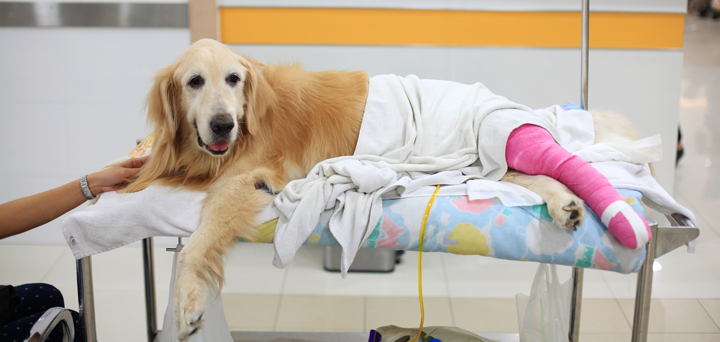ملخص

ما هي إصابة الرباط الصليبي؟
إن إصابة الرباط الصليبي هي تلف واحد (أو كليهما) من الأربطة الصليبية ، إما دمعة صغيرة أو تمزق كامل.
تنكسر بعض الأربطة الصليبية بعد الضعف مع مرور الوقت (مثل حبل متوترة) ، وبعض التمزق فجأة (غالبًا بسبب الضربة أو السقوط).
يظهر هذا الرسم التوضيحي أضرارًا صليبية: إنه إما دمعة صغيرة أو استراحة كاملة في الرباط.

ما هي أعراض الحيوانات الأليفة مع أضرار صليبية؟
يمكن أن يسبب تلف الرباط الصليبي أعراضًا تختلف من عرج طفيف إلى عدم القدرة على وضع أي وزن على الساق على الإطلاق. غالبًا ما تأتي الأعراض فجأة وتشمل:
يوضح هذا التوضيح موقع الرباط الصليبي في الكلاب: تم العثور عليه في ركبة الكلب.

ما هي السلالات المعرضة لخطر الإصابة بالمرض الصليبي؟
يمكن أن تتطور الإصابات الصليبية في أي كلب ، ولكن هناك بعض السلالات (مثل Labrador و Rottweiler و Newfoundland) التي تتعرض للخطر أكثر قليلاً. ومع ذلك ، فإن الكلاب الأكثر عرضة لخطر الإصابة هي تلك التي تعاني من زيادة الوزن ، وتلك التي تمزقها على أرض غير متساوية ، والمطاردة ، والتحول بسرعة ، والانزلاق ، والقفز.
متى تتصل بالطبيب البيطري؟
اتصل بالطبيب البيطري إذا كان كلبك يعرج أو تشك في أنه قد يعاني من إصابة في الرباط الصليبي.
كيف يقوم الطبيب البيطري بتشخيصه؟
لتشخيص المرض الصليبي الذي سيشعر به الطبيب البيطري للحركة غير الطبيعية في مفصل الركبة وأخذ الأشعة السينية.
ما هي خيارات العلاج؟
تحتاج بعض الإصابات الصليبية إلى عملية جراحية ويمكن علاج بعضها بدونه ، سيساعدك الطبيب البيطري على تحديد الخيار الأفضل لك ولكلبك.
بدون جراحة ("العلاج المحافظ")
يعتمد العلاج بدون جراحة ("العلاج المحافظ") على بناء قوة إضافية حول الركبة لإخراج السلالة من الأربطة الصليبية. يستخدم هذا النوع من العلاج في الغالب في الكلاب التي تزن أقل من 10 كيلوجرام والكلاب ذات العلامات الخفيفة. عادة ما يشمل العلاج:
غالبًا ما يستغرق العلاج المحافظ بضعة أسابيع إلى بضعة أشهر ، ولكن إذا لم يكن ناجحًا أو مناسبًا ، فقد يوصى بالجراحة.
جراحة
هناك بعض الخيارات الجراحية المختلفة لمرض الصليبي. يعتمد الخيار الأفضل على وزن الكلب وحجمه ، وما إذا كانت الإحالة إلى الجراح المتخصص هي خيار. تحدث إلى الطبيب البيطري لمزيد من المعلومات.
بعد الجراحة ، سيحتاج كلبك إلى التعافي لعدة أسابيع. سيحتاجون إلى تخفيف الألم ، والراحة الصارمة ، والعودة التدريجية للغاية والتحكم في التمرين. سوف يعطيك الطبيب البيطري تعليمات محددة مصممة لكلبك – من المهم للغاية متابعة هذه للتأكد من أن كلبك لديه أفضل فرصة للشفاء.
ما هي الرعاية المستمرة والتوقعات؟
مع العلاج والشفاء الجيد ، من المحتمل أن يعود كلبك إلى العيش حياة طبيعية نسبيًا. ومع ذلك ، فإن حوالي ثلث الكلاب الذين تعرضوا لإصابة في الرباط الصليبي ، يصابون بمشكلة مماثلة في الركبة الأخرى في وقت لاحق من حياتهم ، لذلك من المهم حمايتهم من إصابة أنفسهم مرة أخرى عن طريق:
ممارسة معقولة
بمجرد أن يتعافى كلبك ، يكون المشي والجري العاديين على ما يرام ، لكن يجب أن يتجنبوا أنشطة شاقة للغاية مثل مطاردة الكرة والقفز والانزلاق.
السيطرة على الوزن
من المهم أن تبقي كلبك لائقًا ونحيفًا لتجنب الضغط غير الضروري على مفاصله وإبطاء تطور التهاب المفاصل في وقت لاحق من الحياة.
التهاب المفاصل
الكلاب التي تعرضت لأضرار في الرباط الصليبي تتطور دائمًا في وقت لاحق من التهاب المفاصل في وقت لاحق من الحياة. لهذا السبب ، سوف يوصي الطبيب البيطري بفحص منتظم وربما مكملات مشتركة.
كيف تمنع مرض الصليبي؟
أفضل الأشياء التي يمكنك القيام بها لمنع مشاكل الصليبية في كلبك هي:

| ملف تعريف الارتباط | مدة | وصف |
|---|---|---|
| cookielawinfo-checkbox-analytics | 11 شهرا | This cookie is set by GDPR Cookie Consent plugin. The cookie is used to store the user consent for the cookies in the category "Analytics". |
| cookielawinfo-checkbox-functional | 11 شهرا | The cookie is set by GDPR cookie consent to record the user consent for the cookies in the category "Functional". |
| cookielawinfo-checkbox-necessary | 11 شهرا | This cookie is set by GDPR Cookie Consent plugin. The cookies is used to store the user consent for the cookies in the category "Necessary". |
| cookielawinfo-checkbox-others | 11 شهرا | This cookie is set by GDPR Cookie Consent plugin. The cookie is used to store the user consent for the cookies in the category "Other. |
| cookielawinfo-checkbox-performance | 11 شهرا | This cookie is set by GDPR Cookie Consent plugin. The cookie is used to store the user consent for the cookies in the category "Performance". |
| viewed_cookie_policy | 11 شهرا | يتم تعيين ملف تعريف الارتباط بواسطة البرنامج المساعد لموافقة ملف تعريف الارتباط الناتج عن القانون العام لحماية البيانات (GDPR Cookie Consent)، ويتم استخدامه لتخزين ما إذا كان المستخدم قد وافق على استخدام ملفات تعريف الارتباط أم لا. ولا يقوم بتخزين أي بيانات شخصية. |